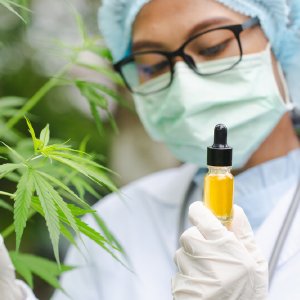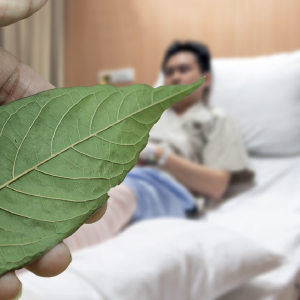Kratom: Will “Wonder Drugs” Never Cease?

What Is Kratom?
Kratom comes from the leaves of an evergreen tree called Mitragyna speciosa, which is indigenous to tropical and subtropical areas of Southeast Asia, including Indonesia, Malaysia, Myanmar, Papua New Guinea, Philippines and Thailand, and parts of Africa. In those parts of the world, kratom has a history of being made into tea or chewed to help reduce fatigue or relieve pain, or used for its euphoric effects. In present times, kratom is mainly used to make powders, pills, and capsules.
Kratom is a stimulant in low doses and a sedative with opioid-like effects in high doses. Use of kratom results in addiction, both psychologically and physiologically. Although it is not listed as a controlled substance, the FDA has not approved it for any medical use and the Drug Enforcement Agency (DEA) has designated kratom as a “Drug and Chemical of Concern.”
The DEA lists kratom’s effects on the body as including “nausea, itching, sweating, dry mouth, constipation, increased urination, tachycardia, vomiting, drowsiness, and loss of appetite. Users of kratom have also experienced anorexia, weight loss, insomnia, hepatotoxicity (liver damage caused by alcohol, chemicals or drugs), seizure, and hallucinations.”

Easy Access
Although you can’t buy it on Amazon, Kratom can easily be purchased online from a large variety of sources, in various colors and types, from powder to extracts, in assorted flavors, “lab tested,” “highest quality,” “organic,” with free shipping or same-day shipping, save 20% on your first order—all of the usual buzz-words and come-ons to reel you in and get you to buy.
And although you can’t buy kratom at your local Walmart or 7-Eleven store, it is not illegal in most parts of the United States. The only states where kratom is illegal are Alabama, Arkansas, Indiana, Rhode Island, Vermont, and Wisconsin. Kratom is also banned in certain counties and cities where it is otherwise legal throughout the state, including Sarasota County, Florida; San Diego, California; Jerseyville County, Illinois; Columbus City, Mississippi; Union County, Mississippi; and Denver, Colorado. It is legal most everywhere else.
In fact, I searched on the internet for “buy kratom near me” and found a long list of smoke shops and head shops where kratom can indeed be purchased near me. I called one of them to verify and, sure enough, all I have to do is get there by their 6:00 pm closing time.
Kratom-Related Deaths
Even though it is not an opioid, the Journal of Clinical Toxicology calls kratom “the herbal opioid,” due to its being touted as an “herbal remedy” as well as being a recreational drug. According to research into kratom-related deaths published in July of 2019, 94% were certified as drug toxicity-related fatalities. The vast majority of those who died of kratom overdose were Caucasian males with a known history of substance abuse. The median age was 36 years.
The study further states that from 2011 to 2017, kratom was reported in more than 1800 cases to poison control centers In 2011, 13 exposures were reported, while in 2017 there were 682 exposures reported. That is an increase of 50 times over a 6 year period, which is equivalent to an increase of about one call per month to nearly two calls per day.

More than half of those reports were in 2016 – 2017, indicating a spike in kratom exposure. From July 2016 to December 2017 there were 152 unintentional overdose deaths that tested positive for kratom, as reported to the State Unintentional Drug Overdose Reporting System. In roughly 60% of those cases, kratom was cited as the cause of death. In the others, the amount of kratom that was mixed in with other drug toxicities was undetermined.
Newborns Going Through Kratom Withdrawal
Neonatal abstinence syndrome (NAS) is a clinical diagnosis based on symptoms that a newborn, who had been exposed to a drug while in the womb, was going through withdrawal. Most often it is from prescription and/or nonprescription opioid use by the mother during pregnancy. What this means is that pregnant mothers taking kratom pass the drug through the placenta to their unborn babies. And after they are born and no longer receiving kratom from their mothers, the babies go through withdrawal from the drug. What a way to come into the world!
A December 2018 article in Pediatrics journal describes a 1 ½ day old infant who started showing symptoms of opioid withdrawal, including “sneezing, jitteriness, excessive suck, facial excoriations, irritability.” The mother denied having used prescription medications, supplements, or illicit drugs during pregnancy. The father reported that the mother had been drinking Kratom tea throughout her pregnancy. The infant was started on morphine, then put on clonidine until he was stabilized and able to be discharged when he was eight days old.
There were other cases of NAS with infants diagnosed with NAS between one and two days after birth, and both successfully managed with morphine or morphine and benzodiazepines. The Pediatrics journal article authors predict that NAS caused by the use of kratom by expectant mothers will increase as more pregnant women try kratom as an alternative to opioid addiction, thinking it has a lower risk for dependency, however, the FDA has found that compounds found in kratom are classified as opioids. And because kratom is not reported on urine drug screens, it will not be detected and so the pediatrician must be aware enough to ask about it. The continuing opioid epidemic strikes again.
Kratom Controversy – Dea vs. The Users
On August 30, 2016, the Drug Enforcement Agency (DEA) announced its intent to schedule kratom as a Schedule I substance due to it being “an imminent hazard to public safety.” A drug classified as Schedule I means it has a high potential for abuse, has no currently accepted medical use in treatment in the United States, and has a lack of accepted safety for use under medical supervision.
“… the FDA has not approved Kratom for any medical use.”
However, the DEA did not declare kratom a Schedule I substance, simply a “drug of concern.” Why the change of intent? The DEA’s drug fact sheet on kratom states it is abused and its use can lead to addiction, further stating “the FDA has not approved Kratom for any medical use.”
Although the DEA's drug fact sheet does not report on medical use in treatment, that’s two out of three points that demonstrate kratom should be labeled a Schedule I substance. Was the DEA bombarded with so many protests from those who favor kratom that it put the decision on hold indefinitely? Whatever the reason, kratom is not a scheduled drug and is readily available to anyone who wants it.
As with many things these days, it really makes me wonder.
Sources:
- https://pediatrics.aappublications.org/content/142/6/e20181839
- https://www.mayoclinic.org/healthy-lifestyle/consumer-health/in-depth/kratom/art-20402171
- https://www.longdom.org/open-access/kratom-the-herbal-opioid.pdf
- https://www.dea.gov/sites/default/files/2020-06/Kratom-2020_0.pdfKratom
- https://www.fda.gov/NewsEvents/PublicHealthFocus/ucm584952.htm
- https://www.dea.gov/press-releases/2016/08/30/dea-announces-intent-schedule-kratom


